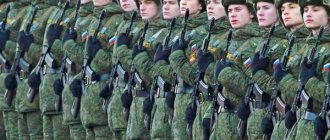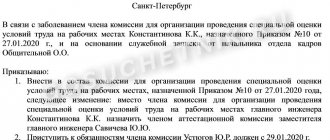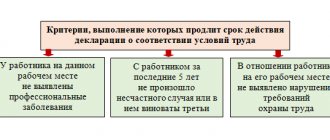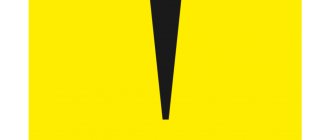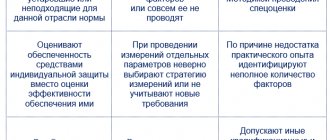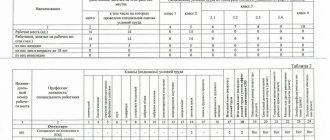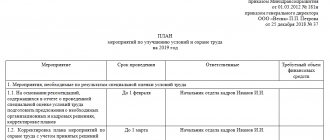27-1: work in difficult conditions
This is the first code of professions that belong to the list of those that involve work in difficult conditions. Encrypted under number 27-1:
- Underground works. They are occupied by people extracting minerals, builders of underground structures, and emergency rescue specialists. The exception is employees whose activities are related to the operation of the metro.
- Work in hot shops. All technologists working in such production are exposed to intense heat. Their health is also affected by the fumes released during the heat treatment process.
- Working in hazardous conditions. This includes activities, the implementation of which leads to negative changes in the body (the appearance of chronic and passing diseases, loss or decrease in performance). This is typical for specialists in the mining, oil, chemical and coal industries, electric power workers, metallurgical and abrasive workers, exploration geologists, microbiologists, radio and electrical engineers, as well as manufacturers of thermometers and hydrometers.
All citizens involved in any of the areas listed above begin to receive insurance pension payments ahead of schedule.
Basic codes for calculating length of service in 2021
Selecting the required code for columns 8 (according to territorial conditions), 9 (for special conditions), 10 (for special periods included in the length of service) and 12 (for conditions giving the right to early retirement) does not present any particular difficulties, since each of these the graph corresponds to its own single table.
Including the table in the appendix, the codes for column 10 SZV-STAZH “Calculation of insurance experience, basis (code)” are clearly interpreted, for which there are no explanations in the text of the procedure for filling out the form. From the table dedicated to them, it becomes clear that work periods require reflection here:
- in seasonally operating industries (SEASON);
- in the field (FIELD);
- in places of deprivation of liberty (PEC 104);
- under water (DIVER);
- in special medical institutions (LEPRO).
The total number of tables corresponding to absence period codes reaches three. What is the reason for such a number of tables, each of which, unlike, for example, those related to columns 9 and 12, is not voluminous? Why aren't they combined into one?
This decision is explained by the fact that two of them relate to employees (registered both under an employment contract and under GPC agreements) and should be used when drawing up SZV-STAZH. Their division into different tables is caused by the indication in one of them of periods of absence included in the length of service, and in the other - those not included in it.
To learn about the conditions under which periods of absence are included in the insurance period, read the material “What is the insurance period for a pension?”
The third table is devoted to the periods taken into account in the length of service of self-employed persons who, during these periods, are not able to pay insurance premiums for themselves. Since self-employed persons do not submit reports on their work experience, the absence codes indicated in this table in SZV-STAZH are not used.
Thus, to fill out column 11, codes will have to be selected based on their meanings contained in two tables in the appendix to the procedure for filling out forms, approved by Resolution of the Pension Fund Board No. 3p.
27-2: special conditions
This code of professions includes activities that involve work under special conditions. And they, in turn, are determined by the following factors:
- Chemical. In particular, increased concentrations of carcinogens and allergens in the workplace.
- Biological. This includes working with poisons, toxins, drugs, and infected material.
- Physical. These factors include all types of radiation, as well as human exposure to noise, vibration, as well as geomagnetic and electromagnetic fields.
- Circumstances. These are overloads, monotonous movements, intense impact on vision and eyes, and the worker staying in the same position for a long time.
The list of these factors has been approved by the Ministry of Health; it is required to be taken into account when signing an employment contract with an employee.
If we talk about specific examples, code 27-2 is assigned to the following professions:
- Everything related to metal processing.
- Ice producers.
- Drillers, dredgers, equipment operators, crushers.
- Skin processors.
- Dough mixers.
- Salt miners.
- Workers of sea fishing vessels.
- Food raw material washers.
- Port stevedores.
This, of course, is not the entire list of professions, but only some examples. I would also like to note that not every person can be allowed to work under difficult and harmful working conditions. There are contraindications, and these include:
- Congenital malformations.
- Chronic skin diseases.
- Cataplexy or narcolepsy.
- CNS disorders.
- Alcohol or drug addiction.
- Glaucoma.
- Any, even minor, diseases of the cardiovascular system.
That is why all candidates undergo a full medical examination before employment.
Add. tariffs 2019 (special assessment was carried out): table
Starting from January 1, 2014, employers are required to conduct a special assessment of working conditions in accordance with Federal Law dated December 28, 2013 No. 426-FZ. Based on the results of a special assessment of working conditions, classes and subclasses of working conditions are established, on the basis of which an additional tariff for contributions to the Pension Fund is determined (Article 58.3 of Law No. 212-FZ). It should be borne in mind that contributions for additional tariffs are not always calculated.
To determine whether or not to accrue contributions to the Pension Fund at additional tariffs, you must be guided by Lists No. 1 and No. 2 (approved by Resolution of the Cabinet of Ministers of the USSR dated January 26, 1991 No. 10). If an employee’s position is included in one of these lists, then contributions to the Pension Fund using additional tariffs are calculated on his payments.
Persons employed in underground work, in work with hazardous working conditions and in hot shops (clause 1, clause 1, article 27 of the Federal Law of December 17, 2001 No. 173-FZ)
2014 — 6.0% – joint part of the tariff
2015 — 9.0% – joint part of the tariff
Persons employed in work with difficult working conditions and other hazardous work (clauses 2 – 18, clause 1, article 27 of the Federal Law of December 17, 2001 No. 173-FZ)
2014 — 4.0% – joint part of the tariff
2015 — 6.0% – joint part of the tariff
| Class of working conditions according to the degree of harmfulness and/or danger | Subclass of working conditions according to the degree of harmfulness and/or danger | Contribution rate |
| dangerous | 4 | 8% |
| harmful | 3,4 | 7% |
| 3,3 | 6% | |
| 3,2 | 4% | |
| 3,1 | 2% | |
| acceptable | 2 | 0% |
| optimal | 1 | 0% |
– payments in favor of persons entitled to early assignment of a labor pension;
– payments and rewards in favor of the employee from the moment of registration of an employment relationship with him, providing for work under special working conditions. The length of time during which the employee is directly exposed to harmful factors (daily during the billing period or periodically, according to production needs) does not affect the procedure for calculating insurance premiums;
– payments in favor of an employee entitled to early retirement, regardless of working hours (for example, part-time or part-time work week);
– if the employee is already a pensioner (that is, already receiving early retirement), but continues to work under special working conditions, the calculation of pension contributions at additional rates for payments to such a person continues.
Calculation of insurance premiums at an additional rate for insured persons employed in workplaces not specified in subparagraphs 1–18 of Art. 1 of Law No. 173-FZ, the legislation of the Russian Federation does not provide for insurance premiums. Insurance premiums at additional tariffs for payments made in favor of employees whose workplaces have working conditions based on the current results of workplace certification (or from 01.01.
Reporting to the Pension Fund
section 2 has been supplemented with a new subsection 2.4, which reflects information on insurance premiums for an additional tariff depending on the class (subclass) of working conditions, which was established based on the results of a special assessment;
columns 3 and 13 have been added to section 4, which reflect additional accrued additional contributions paid based on the results of the special assessment (part 2.1 of article 58.3 of Law No. 212-FZ);
the column “Special labor assessment code” has been added to section 6 of subsection 6.7. The meaning of these codes can be found in Appendix No. 2 to the Procedure for filling out the calculation according to the RSV-1 Pension Fund form.
Reporting to the Social Insurance Fund
Table 10 “Information on the results of a special assessment of working conditions and mandatory preliminary and periodic medical examinations of workers at the beginning of the year” of Section II of the calculation in Form-4 of the FSS, starting with reporting for the first quarter of 2014, is filled out and submitted without fail (clause 2 Procedure for filling out form 4-FSS). This table has been updated due to the introduction of a special assessment of working conditions.
Table 10 reflects data on a special assessment of working conditions, as well as on mandatory preliminary and periodic medical examinations carried out at the beginning of the year (paragraphs.
The general procedure for using additional tariffs is specified in Article 428 of the Tax Code of the Russian Federation. They are used for certain categories of workers employed in certain jobs, depending on the age of the workers and length of service. But only on the condition that the employer did not carry out SOUT.
| Works | Tariff for compulsory pension insurance |
| Underground, with hazardous working conditions and in hot shops | 9 % |
| With difficult working conditions | 6 % |
| As tractor drivers in agriculture and other sectors of the economy, as well as drivers of construction, road and loading and unloading machines (for women) | |
| With increased intensity and severity in the textile industry (for women) | |
| In expeditions, parties, detachments, at sites and in teams during field geological exploration, search, topographic and geodetic, geophysical, hydrographic, hydrological, forest management and survey work | |
| As working locomotive crews and workers of certain categories, organizing transportation and ensuring traffic safety on railway transport and in the subway, as well as as truck drivers in the technological process in mines, open-pit mines, mines or ore quarries for the removal of coal, shale , ores, rocks | |
| Provided in paragraphs 7-18h. 1 tbsp. 30 Federal Law dated December 28, 2013 No. 400-FZ |
| Working conditions | Assessment of working conditions | Tariff for compulsory pension insurance |
| Dangerous | 4 | 8 % |
| Harmful | 3,4 | 7 % |
| 3,3 | 6 % | |
| 3,2 | 4 % | |
| 3,1 | 2 % | |
| Acceptable | 2,0 | 0 % |
| Optimal | 1,0 | 0 % |
If you find an error, please highlight a piece of text and press Ctrl Enter.
27-3: women's labor
Continuing to talk about special working conditions, it’s worth moving on to the next code. Number 27-3 is assigned to women's activities related to specific areas. This includes tractor drivers in agriculture and other economic sectors, as well as operators of loading and unloading, road and construction machines.
Work in such areas of activity is difficult for objective reasons. Moreover, she is characterized as masculine.
Take, for example, the profession of a tractor driver. While working, he is exposed to vibration and noise, and spends about 1/3 of his time in an extremely uncomfortable position.
He also needs to manage, repair, and maintain in working order different types of tractors, trucks and combines. In addition, the tractor driver plows and sows the land, removes rotten crops, transports successful crops, prepares food, clears snow, and digs trenches.
Of course, all this is special working conditions for men, but for women, everything listed earlier is placed in a separate category, designated by a personal code.
27-4: textile industry
This is also how women’s work is designated, but only in the textile industry, in work with increased severity and intensity.
Specialists involved in this field are engaged in the processing of fibrous substances of synthetic, animal, vegetable and mineral fibers. This process consists of several operations. These are extraction, production, spinning, weaving, and finishing of fiber.
All this requires significant physical stress from workers. It is not surprising that an assessment of working conditions in textile production revealed that they are difficult. After all, the following factors influence employees:
- Increased air humidity and temperature.
- High frequency noise 94-105 dB.
- Air dustiness.
- Strong vibrations.
- Toxic substances that may come into contact when bleaching fabrics.
- The employee is in an upright position with frequent bending and moving.
- Visual intensity.
- Extreme concentration of attention.
note
2.1. If you have two “identical” positions with different working conditions, then from the point of view of the program, these are two different positions. You need to create two elements of the “Positions” directory, fill in the different working conditions and assign each employee a position in accordance with his working conditions.
In addition, all changes in working conditions for the same employee should be reflected in personnel movements from one position to another. We would like to remind you that, according to letters from the Ministry of Labor of Russia, if an employee is part-time for a month in work with harmful, difficult and dangerous working conditions, the calculation of insurance premiums at an additional rate is proportional to the time worked in the relevant types of work under special conditions. If you carefully reflect all changes in special working conditions, the program itself will calculate the taxable and non-taxable portions of the accruals under the additional tariff.
More details on ITS in the section “Information on updates to 1C:Enterprise software products”: https://its.1c.ru/db/updinfo#content:88:1:IssOgl1_1
In this article on ITS you will find answers to the questions:
1) how contributions are calculated from the accrual relating to a specific period of time (from the main accrual) if the working conditions change in this period;
2) how contributions are calculated from a one-time accrual that does not relate to any specific period of time;
3) how contributions are calculated from the additional accrual for the last month made after the payment of wages;
4) the procedure for additional accruals for the previous period for already dismissed employees.
2.2. If for two “identical” positions a special assessment of working conditions was carried out in different months (for example, for each of the two legal entities in your database the procedure was carried out at different times), then we again need to create two positions in the directory. It seems to us convenient to have two positions in the directory: “not certified” and “certified.” And as the assessment is carried out and a class is assigned, the employee is transferred from a “non-certified” position to a “certified” one.
27-6: work in open areas
This code denotes the following works:
- Exquisite.
- Hydrological.
- Geophysical.
- Forest management.
- Hydrographic.
- Search engines.
- Geological exploration.
- Topographic and geodetic.
That is, all people who work in detachments, expeditions, brigades and sections belong to this category.
27-7: rafting and logging
Above we talked about above-ground and underground work. Code 27-7 denotes “related” activities. To be more precise, work in timber rafting and logging. This also includes maintenance of equipment and machinery.
Here are some professions from this category as an example:
- Forest fellers.
- Winches on the skid.
- Riders.
- Crosscutters.
- Skidding machine operators.
- Lumberjacks.
- Wood sorters on the water.
- Crane operators.
- Drivers of a car hauling timber.
- Loaders.
- Branch cutters.
- Rafters.
- Equipment repair mechanics.
27-8 and 27-9: work in the port
These codes can be combined for a logical reason, because they include areas related to the port.
So, first we should talk about code 27-8. It denotes the area of loading and unloading port activities in which machine operators of complex teams are employed.
Code 27-9 defines a wider spectrum. To be more precise, work as a crew member on river, sea and fishing fleet vessels. The following ships are exceptions:
- Port workers who work in the port waters.
- Traveling.
- Service and auxiliary.
- Intracity and suburban communication.
27-10: chauffeur activity
This code designates the profession of drivers of trams, trolleybuses and buses. They are also workers with special working conditions. And there are many factors that determine the level of difficulty:
- Technical: type of transport, gross weight, technical condition, dynamic characteristics, dimensions, presence/absence of a trailer.
- Technological: route features, characteristics of the cargo, its dimensions, availability of special equipment.
- Organizational: passenger flow, stability, length and non-linearity of the route, frequency of stopping points, schedule.
- Social: the driver’s age, his length of service, work and rest schedule, qualifications, length of the working day, combination of duties.
- Road climatic: mountain or quarry conditions, nature and climate, condition and type of road surface.
- Ergonomic: level of vibration and noise, ease of location of control levers, dust, ventilation and temperature in the cabin, visibility and illumination, thermal radiation, air humidity, space.
- Economic: organization of work, features of its payment and distribution of salaries in the team, financial indicators of the enterprise.
- Organizational and technical: frequency of intersections, traffic intensity, permitted speed and road capacity.
And these are not all the factors taken into account when assessing working conditions. Of course, visually the actions performed by the driver are simple. But there are a lot of them, and all of them together create an incredible burden.
What is coded in the experience report?
What information is needed to fill out the SZV-STAZH form? Information is encoded in this report that reflects working conditions and periods that are specifically taken into account in the length of service, i.e. codes for the features of calculating length of service are needed in SZV-STAZH. It should be noted that they are used only if there are grounds for such accounting, and for columns 9, 12 and 13 only when these features are confirmed by documents.
Codes are entered in SZV-STAZH 2021 in columns of the main table 8–12, where they indicate the presence of the following that require accounting:
- territorial conditions (column 8);
- special working conditions (column 9);
- special periods included in the length of service (column 10);
- periods of absence from work, both included and not included in the length of service (column 11);
- conditions for early assignment of a pension (column 12).
For a sample form, see the article “How to fill out the SZV-STAZH form for 2021 for submission in 2018?”
Lists of codes used in SZV-STAZH with an explanation of their meanings are given in the document that approved this form itself (Resolution of the Board of the Pension Fund of the Russian Federation No. 3p). They represent an annex to the procedure for filling out forms approved by the same resolution (i.e., to its Appendix No. 5), in which the codes are summarized in tables characterizing groups of conditions and containing:
- code cipher;
- its decoding;
- a list of legislative acts justifying the application of each condition;
- code validity period.
In the text of the filling procedure related to SZV-STAZH, there are examples of the use of codes.
27-ПЗ: fire service
This code is assigned to positions related to the fire service. Here are just a few professions taken from the list:
- Fire truck driver.
- Spotlighter.
- Boatswain of a fire ship.
- Operational detachment duty officer.
- Communications dispatchers working in the Ministry of Emergency Situations of Russia.
- Fire engineers.
- Prevention instructors.
- Fire department and department commanders.
- Gas and smoke protection service specialists.
- Chiefs of the detachment, guard, fire trains, mobile pumping stations.
Of course, the list is incomplete. And you don’t even need to clarify why the working conditions in the fire service are special. People come into contact with uncontrollable elements that destroy everything around them - they are always in danger.
Data included in SZV-STAZH
SZV-STAZH is a form of annual reporting on the length of service of employees, used starting with the report for 2021 (Resolution of the Board of the Pension Fund of the Russian Federation dated January 11, 2017 No. 3p).
The need for its appearance was caused by the abolition of the previously used quarterly form RSV-1, which was submitted to the Pension Fund of the Russian Federation and contained information on the calculation and payment of insurance premiums for compulsory health insurance, as well as information on length of service. Since 2021, control over the calculation and payment of contributions has passed to the tax authorities; quarterly reports began to be submitted there, combining data on accruals for all insurance premiums transferred to the jurisdiction of the Federal Tax Service (OSI, compulsory medical insurance, compulsory social insurance, except for contributions for injuries). This reporting also includes a section with information about accrual of payments to compulsory pension insurance made in relation to the income of each employee personally.
However, information about the length of service was not included in the new reports submitted to the Federal Tax Service as it is not related to the calculation and payment of contributions. Control over data on length of service remained with the Pension Fund of Russia, but the submission of information about it became annual. It is for this annual reporting that a new reporting form (SZV-STAZH) was introduced.
The form reflects information about the policyholder (name, registration number, TIN, KPP), the type of information submitted (initial, supplementary, intended for calculating a pension) and the year for which the report is submitted. To enter basic information (about the length of service of employees), there is a table reflecting the information:
- about full name and SNILS of employees (columns 2–5);
- the period of their work for the reporting year (columns 6–7);
- working conditions and periods specially taken into account in the length of service (columns 8–13);
- the fact of dismissal on December 31 of the reporting year (column 14).
Under the table there are sections for marks indicating the fact of accrual and payment of contributions, which are required to be filled out only when submitting information about the length of service for calculating a pension.
